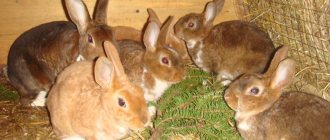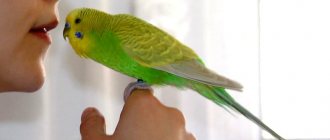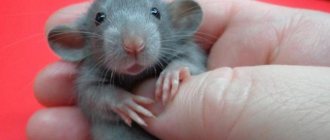- home
- Rabbits
- Character
19.02.2018
The domestic rabbit is an amazing animal, affectionate and friendly towards children and adults. After completely mastering the new home, it is recommended to tame the rabbit. He must learn to trust you, otherwise he will experience stress with every contact. The health and life expectancy of the pet depends on this. After accustoming your rabbit to your hands, he will no longer experience fear when in contact with you, it will be a joy for him.
Do you need to tame a rabbit?
If there is such an opportunity, it is imperative to tame a small rabbit. One way or another, it is necessary to frequently contact him, feed him, wash him and cut his nails. If the animal is afraid, this will significantly complicate care. In addition, such things will be seriously stressful. On the other hand, you can accustom your rabbit to your hands, then he will not be afraid of you. You can let him walk around the house and easily catch him. No problem washing and cutting your nails. It is important to know how best to accustom a decorative rabbit to your hands, since not all methods are equally effective.
You can tame any pet, regardless of breed. But it is much easier to train from an early age so that the pet gets used to you from the time it can remember. You can teach an adult rabbit, but it will take much more time. The sooner you start training, the less time it will take.
What determines the character of the animal?
The behavior of the eared dog depends on past experience, age, parents and some less significant factors. If you have experienced violence in the past or had negative experiences with people, training will be difficult and lengthy. It is easier to tame at a young age, but even if the training results are disappointing, over time the rabbit may fall in love with you. The result greatly depends on how your parents treat you. The youngsters learn everything from them. If they were taught not to be afraid of a person and to freely go to their hands without fear, the little rabbit will quickly follow the example and behave the same way.
Breeds that are easy to tame
You can tame any rabbit, both decorative (dwarf) and ordinary. The only difference is how much effort and time will have to be spent on the taming process. Dwarf rabbit breeds are distinguished by their good-natured and friendly character. They have a positive attitude towards people, so they easily make contact.
Among all the existing breeds of decorative rabbits, there are those that are much easier to tame.
| Breed name | Main characteristics |
| Dutch | The most common breed. Sociable, calm, trusting, obedient and stress-resistant animals. They require a lot of attention and love to be played with. |
| Lionhead rabbit | They have a fur collar around the neck, which is how the breed got its name. Playful animals with a gentle and gentle disposition. |
| Miniature Fold | It has an attractive appearance. His long drooping ears give him a funny look. Due to its playfulness and curiosity, it is an excellent pet for children. |
| Dwarf ram | They are easy to train, get along well with their owner and are not afraid of people. They do not show aggression towards others. |
| Chinchilla | The breed received its name due to the similarity of the bluish-gray fur of a rabbit with the color of the fur of the rodent of the same name. The animal is short-haired and incredibly fluffy. Smart, obedient, friendly and gentle. |
| Angora | Very fluffy bunnies. They need careful grooming, as their downy fur tends to form tangles. Responsive to affection and attention. They are trainable and love to demonstrate learned tricks. |
| Mini Rex | Rabbits with velvety, soft fur. Very calm, easy to get along with. |
| Himalayan | A pet with a calm character, sociable and not prone to aggression. Loves communication with people. |
| Dutch | Calm and balanced animals. They need the company of their relatives, so keeping them in pairs is recommended. |
Pet taming process
From the above, it is clear how important it is to tame a rabbit at the first opportunity. First of all, give time to adapt to your new place of residence. He should feel free in the cage, feed him and give him time to inspect and sniff everything. After the pet finds a place to rest and rests, training can begin.
Talk to your pet in a quiet, gentle voice. When he gets used to it a little, slowly extend your palm and let him sniff it. For better persuasiveness, you can hold a tasty treat in your hand. This will give you more confidence and reduce your stress levels.
When the pet gets used to your hand and is not afraid of it, you can release it onto the floor. Sit next to him and wait for him to come up. Now gently reach out and lightly stroke the fur. If he doesn't want contact for a long time, offer him a treat and continue to wait. Now it is necessary that he feels free to be near and in his arms. After this, you can pick it up, lifting it off the ground.
Animals understand on a subconscious level when they are fed and loved. The best way to make contact is to feed them delicious food. Favorite foods have a positive effect on the body, even their smell reduces stress and increases confidence.
Little rabbits are tamed from the first days of living in the house. This does not apply to newborns. Talk to him regularly, give him treats so that your pet can see your hand. After a short time, the rabbit will understand who is feeding it, and will feel less and less fear towards you. Then they begin to accustom him to hands.
Display of aggression
Despite the fact that for the most part rabbits are quite affectionate and friendly animals, there are also aggressive individuals with difficult characters among them. They do not want to obey the owner, they behave inappropriately during feeding, they rush to their feet, kick, and try to bite them. Rabbits scratch and bite quite painfully and noticeably.
But this behavior can be corrected. Most often it is characteristic of adult animals that have changed their place of residence and owner. Intelligent and intelligent individuals also behave aggressively, expressing themselves in this way. The main thing is to establish contact with them during taming and redirect their unfriendly energy into a peaceful direction. Such animals require a special approach to training, but after taming they become devoted pets.
Among the main reasons provoking aggressive behavior in animals are the following:
- sudden fear and fear of causing pain (typical of animals that are not accustomed to affectionate treatment, and as a result have the habit of defending themselves);
- puberty and sexual arousal;
- illness or poor health;
- changes in hormonal levels in pregnant females;
- protection of offspring by lambing rabbits.
To understand what causes aggression in a rabbit, you should observe it for some time.
This can be either annoying and frightening sounds in the room (music, TV, the noise of a vacuum cleaner or refrigerator), or the touch of the owner, his loud voice. If possible, all irritating factors should be removed.
It is necessary to surround your pet with care and attention, letting him know that he is welcome in the house. It's best to take unfriendly behavior with humor. When a rabbit approaches, you should slowly move away to a safe distance from it. If he tries to attack or aggressively rushes around the room, calm, affectionate communication can help.
It takes some time for a rabbit to adapt to new conditions, so be patient. On average, the habituation period lasts several weeks, during which the animal learns to trust its owner.
How to stop biting
In stressful situations, a rabbit may bite. Don't hold it against him for this behavior. This is due to basic fear and self-defense. An animal will not bite the hand that feeds it, of course, if it recognizes it. You shouldn’t try to pick it up from the first days. As mentioned above, first let your rabbit get used to the voice.
To avoid unpleasant bites, do not remove your rabbit from its cage against its will. If he resists strongly, it is better to leave him alone. Under no circumstances should you be punished for biting. This is the only method of self-defense that occurs during severe fear. If you also punish for this, the pet will be afraid for a very long time.
You can react to a bite with a loud short cry so that the pet understands that self-defense was effective. After this, quickly return it back to the cage. When the conflict is forgotten, give him some treats.
Let's start training
So, the animal is friendly towards you, it is in a good mood and a little hungry. This means you can start training. It is worth noting that if you plan to practice outside, consider how to arrange a fenced area. This should be a level, safe place, preferably short grass. At home, you can study anywhere. Again, don't forget about safety.
Learning a name
It's great when an animal responds to its name. To learn this skill, you need patience and a small piece of delicacy: parsley, an apple or juicy grass. Call your rabbit and show him the treat. If he turns towards you, give him a treat and be sure to praise him. Try to pronounce your nickname with the same intonation.
If the rabbit does not react, it means that he is not interested in the food. It's okay, repeat this technique after a while. Don't be nervous and don't scold the animal. In a few days he will rush to you upon hearing his nickname.
Making a stand
This trick delights the audience. On command, the roller stands on its hind legs and stretches out like a soldier. This technique is not difficult to teach. Let the animal take a bite of its favorite treat, and then raise your hand a little higher. At the same time, say the command out loud, for example, “Tosha, up.”
Raise the treat a little higher each time. Just do not make sudden movements, otherwise an untrained rabbit may fall backwards. After some time, the rabbit will develop a reflex and will respond to the command. Or you can teach him not only to stand, but also to run on his hind legs. Don't forget to reward every success with a treat.
Ball game
When a rabbit plays with a ball, pushing it with its muzzle, it looks very funny. It seems that your pet is an avid football player. To teach him this game, hide a small piece of carrot or parsley under the ball. Show the animal that there is a treat under the ball. Then he will try to move the ball with his nose.
After a while, your pet will start playing with the ball as soon as he sees it in order to get a treat. Or you can complicate the task and teach the rabbit to score a goal. Glue a piece of food to the ball with tape so that the animal cannot eat it right away. Place the ball in front of the toy goal and wait for the animal to accidentally push it between the bars, and then give it a treat. Ushastik will quickly remember how to get the desired treat.
Skateboarder
Make a small skateboard the size of your pet. To start, simply place your rabbit on it and give it a gentle ride. When he gets used to his new transport, make a path with a slight slope, place a skateboard on top and call the eared one. To return to the owner, he will slide down the hill. It looks very impressive, and it will not be difficult to teach.
Turn over the saucer
This trick is similar in principle to playing catch. Only flat objects are more convenient for a rabbit to turn over with its teeth. Place a treat under the saucer where the rabbit can see it. He will try to lift the obstacle and get the treat. Be patient, because the animal will need skill to turn the object over. You can stick a piece of food with tape to the bottom of the plate.
Obstacle course
When your pet is already quite dexterous and brave, teach him to go through an obstacle course. You can make all kinds of bridges, tunnels and labyrinths. Start with one element, the simplest one, and gradually add new obstacles. It looks very cool when the animal walks across a swing bridge or climbs to a great height.
How to litter train a rabbit?
Tray training rabbits is not difficult. First you need the tray itself; you can make it yourself or buy a ready-made one. Fill it with sawdust, shavings or other filler. You are required to observe the animal and find a place where the need is relieved. Mostly this is one of the corners of the cell. Just place the tray in this place and wait for the pet to do its business there. For greater persuasion, you can add a little dirty sawdust to the toilet so that the rabbit can smell itself and have no doubt that it is necessary to relieve itself here.
What to do with aggressive rabbits?
With a certain amount of time and patience, you can accustom almost any rabbit to handling. Some owners stop training at the first sign of aggression. You shouldn’t do this, you just need to find out why your pet behaves this way. By identifying and eliminating the irritating factor, you can quickly make the animal tame.
If you know the reasons for aggression, it is quite easy to teach your pet:
- Most often, this situation arises due to elementary fear; the pet tries to protect itself by showing character. Try not to do anything that causes fear. Speak quietly, make only smooth movements, and never suddenly grab your pet.
- During puberty, animals become noticeably more aggressive. Trying to show their superiority and dominance, they may even bite. In such cases, order in a stern but quiet voice and quickly return him to the cage. Several such situations and the pet will understand who is in charge.
- During pregnancy, the female rabbit shows aggression to protect herself and her offspring. Don't try to fight this and teach her. Just leave it alone and wait for the young to be born.
This behavior can cause stress. Allow the animal to move away and completely calm down, only then can you continue training.
What factors can influence an animal's behavior?
Decorative rabbits are friendly. But sometimes they start to show aggression and bite. Experts note a number of factors that influence the behavior of animals and cause abnormal behavior on their part.
- Sexual overstimulation during estrus and puberty.
- Attracting a person's attention.
- Protecting your territories.
- Excessive attention from people.
Be caring and kind to your pet and he will respond to you with sincere affection and love!











